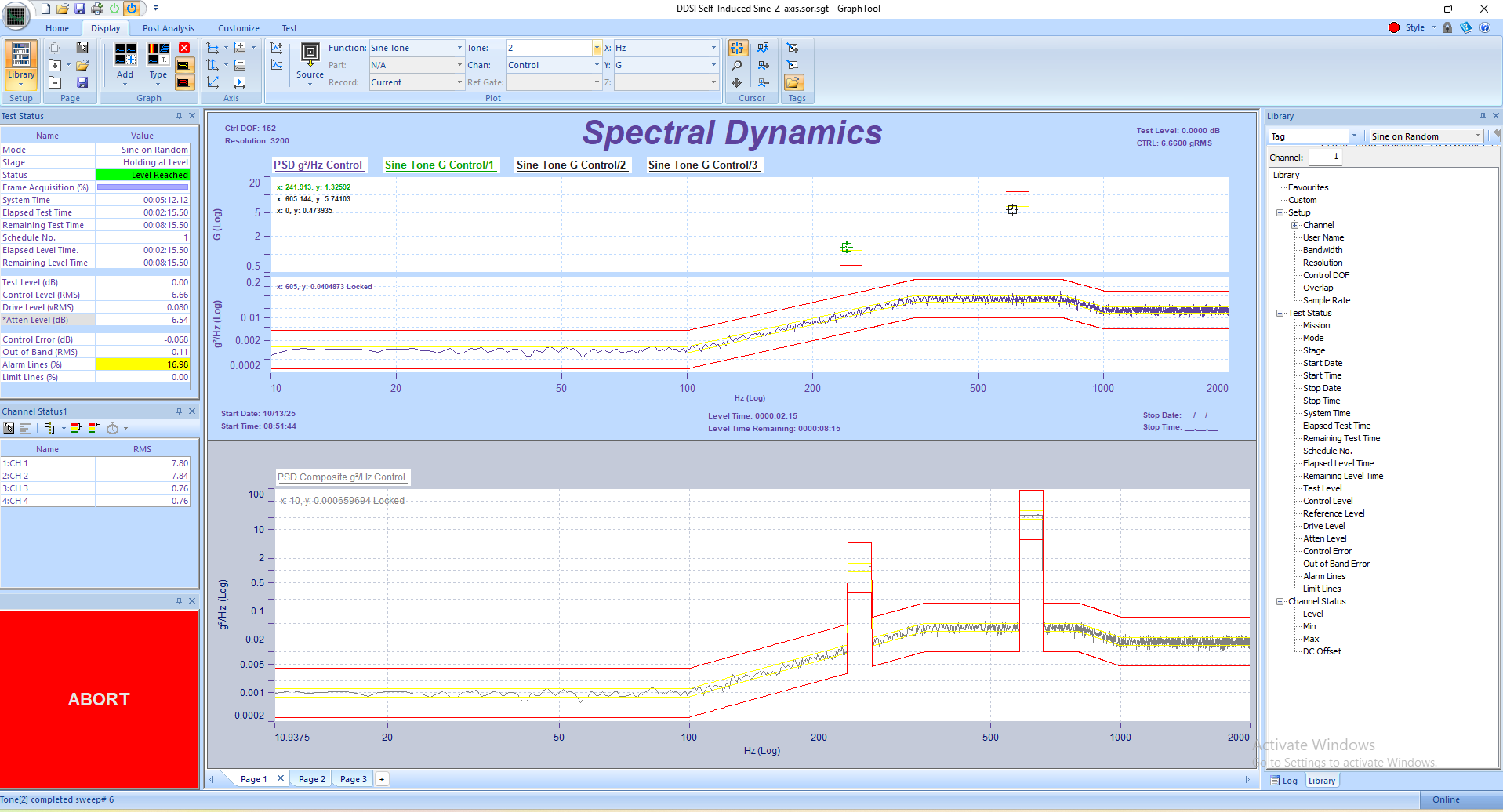Sine On Random
Panther Sine on Random Control delivers precision and performance in mixed-mode vibration testing. Built on Spectral Dynamics' heritage as the inventor of closed-loop digital vibration control, Panther combines advanced adaptive algorithms, comprehensive safety, and intuitive operation to provide trusted results, every time. The Sine on Random application reproduces complex environments found in aircraft engines, rotating machinery, and space vehicles—where narrowband tonal energy coexists with wideband random energy. When quality of data is important, Panther sets the standard.

How It Works
Panther's dual-loop control system maintains independent regulation of the sine and random components. Using proprietary multiple filters optimized for complex waveform generation, Panther ensures both the sine tones and random background are accurately controlled simultaneously. Adaptive tracking filters ensure sine tones remain locked in amplitude and frequency even as the random background varies, while true Gaussian random generation maintains precise spectral control. The result is fast, stable, and repeatable mixed-mode testing under full closed-loop control.
Real-time feedback continuously adjusts both signal components to maintain accuracy under nonlinear or time-varying test conditions. Gap-free streaming ensures all data is recorded for post-test analysis, while Panther's hardware-synchronized acquisition provides phase coherence better than one degree between all channels up to 100 kHz.
Ease of Use & Flexibility
Panther's Sine on Random application simplifies even the most complex mixed-mode test setups. Through the Library feature, users can instantly access saved setups, data, and reports without navigating complex file paths. The intuitive interface enables fast configuration management and instant access to prior test configurations. The interface supports touch-screen operation and customizable layouts for both production and R&D environments. Easily and quickly compare data from different channels and different test runs. Panther's modern, touch-friendly interface makes operation fast and intuitive, for engineers at all experience levels.
Advanced Sine on Random Control Technology
• Simultaneous Closed-Loop Control — Independent regulation of broadband random and discrete sine tones with proprietary multiple filters for optimal control.
• Adaptive Tracking Filters — Ensures precise control of sine amplitude, frequency, and phase while maintaining random background accuracy.
• True Gaussian Random Generation — Maintains precise spectral control and repeatable test results for the random component.
• Real-Time PSD and Harmonic Monitoring — Live visualization in GTX provides full test visibility of both sine and random components.
• Proprietary Composite Plot — Unique visualization tool for analyzing sine tones superimposed on random PSDs, enabling instant identification of interactions.
• Gap-Free Data Streaming — Records all channel data in real time without data loss for complete post-test playback and verification.
• Multi-Stream Acquisition — Supports independent sample rates per stream with synchronized high-speed sampling across all channels.
• Automatic NIST-Traceable Calibration — Ensures measurement accuracy for both input and output channels with automatic channel matching.
• Full Channel Synchronization — Maintains precise phase alignment across all channels (< 1 µs) for accurate multi-axis testing.
• Integrated Safety Monitoring — Performs over a dozen system and signal checks 25 times per second with real-time abort thresholds.
• Modern Touch-Optimized Interface — Touch-friendly user interface designed for simplified setup and operation on Windows PCs and tablets.
• High-Resolution Acquisition — With simultaneous sampling across all channels at up to 262,144 samples per second and 24-bit ADC resolution, Panther accurately captures the full frequency range required for demanding Sine on Random testing.
Safety and Reliability
Panther continuously monitors over a dozen critical parameters up to 25 times per second. Built-in watchdogs, automatic abort thresholds, and real-time feedback ensure operator and equipment safety. Safety isn't an afterthought — it's designed into the system.
Applications
Aerospace • Automotive • Defense • Electronics • Transportation • Energy
• Aerospace propulsion system testing
• Rotating machinery and gear analysis
• Mixed-mode qualification tests
• Acoustic and vibration combined environments
• Resonance tracking and dynamic response studies
Technical Data Sheet
|
Input Subsystem |
Output Subsystem |
|
Input Channels: 8 channels (expandable up to 32) |
Dynamic Range: >110 dB |
|
Dynamic Range: >110 dB |
DAC: 20 Bit |
|
ADC: 24 Bit |
Max Output Amplitude: ±12 Volts Peak |
|
Voltage Ranges: ±12 V to ±0.5 V in 8 steps (Auto Ranging) |
Max Output Current: 16 mA |
|
Overload Detection: Full scale on all channels, analog and digital detection |
Amplitude Linearity: ±0.20% of value or ±0.03% of full scale |
|
Voltage Coupling: AC or DC or GND |
Max Output Rate: 262,144 samples per second |
|
IEPE Power: 4 mA (24 V max into open circuit) |
Image Attenuation: <96 dB |
|
Max Rated Input Signal: ±35 Volts Peak |
Frequency Accuracy: ±5 ppm |
|
Max Sampling Rate: 262,144 samples per second |
Reconstruction Filters: Analog (1 kHz, 10 kHz, 25 kHz or OFF, >96 dB attenuation, ±0.15 dB ripple) |
|
Sampling Interval: Simultaneous on all channels |
Output Offset Removal: Digitally Controlled, Accuracy Better than ±0.5% of Full Scale |
|
Frequency Accuracy: ±5 ppm |
Channel-Channel Match: ±0.25 dB amplitude, ±1° phase to 100 kHz |
|
Freq. Range Reduction: Digital decimation and filtering using on-board FPGA and DSP |
Channel Crosstalk: <-100 dB |
|
Anti-Aliasing Filters: Analog (524 kHz cutoff, >105 dB alias attenuation, ±0.10 dB ripple); Digital (variable, >96 dB @ Nyquist, ±0.15 dB ripple) |
Phase between Units: ±1° to 100 kHz |
|
Input Impedance: 1 MΩ |
Output Impedance: 60 Ω |
|
Connection Type: Pseudo-differential, 10 Ω to system ground, low side return |
Output Type: Pseudo-Differential, 10 Ω to System Ground Low Side Return |
|
Calibration: Automatic Internal Digital Calibration, NIST Referenced |
COLA Output Level: 1 Volt Peak (after analog smoothing filter) |
|
TEDS Compliant: Yes |
Output Cable: Designed to drive up to 50 ft of shielded 50 Ω coaxial cable |
|
|
Calibration: Internal Digital Calibration, NIST Referenced |
|
|
Host Communication: USB or Ethernet or Optional Wi-Fi |

